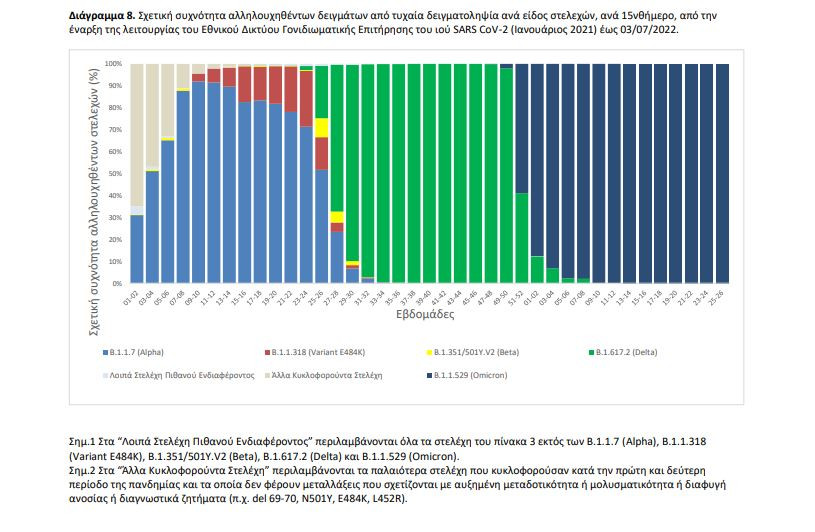The samples come from the Region of Attica and the cities of Thessaloniki, Larissa, Volos, Heraklion, Chania, Agios Nikolaos Lasithi, Patras, Xanthi, Alexandroupoli, Ioannina and Corfu.
The results of the laboratory tests of the National Wastewater Epidemiology Network for the epidemiological surveillance of the SARS-CoV-2 virus in urban wastewater, which operates under the coordination of the EODY, were announced today.
The samples come from the Region of Attica and the cities of Thessaloniki, Larissa, Volos, Heraklion, Chania, Agios Nikolaos Lasithi, Patras, Xanthi, Alexandroupoli, Ioannina and Corfu.
The samples are taken from the inlets of the local Sewage Treatment Units (STUs) and correspond to the population served by them.
Table 2: Percent change in mean concentration of SARS-CoV-2 viral load in municipal wastewater per 100,000 inhabitants per week 11-17/07/2022 in relation to the week 04-10/07/2022.
Conclusions: During the week of July 11 to 17, 2022, increasing trends were observed, compared to the week of July 4 to 10, 2022, in the average weekly viral load of SARS-CoV-2 in municipal wastewater in eight of the twelve (8/12) areas tested from the National Wastewater Epidemiology Network (EDEL) of EODY, a reduction in three of the twelve (3/12) areas of the EDEL and stabilization in one of the twelve (1/12) areas of the EDEL. There were clear upward trends in the average weekly viral load of urban wastewater in Chania (+245%), Patras (+49%) and Volos (+44%), while the increase was marginal in Larissa (+30%), in Thessaloniki (+28%), Alexandroupolis (+22%), Agios Nikolaos (+20%) and Xanthi (+17%). Net downward trends were found in Attica (-57%), while marginally downward trends were seen in Corfu (-29%) and Heraklion (-11%). The viral load of municipal sewage in Ioannina remained stable (+5%).
Region of Attica: In the last week, 11-17/07/2022, the average weekly viral load in the municipal wastewater of the Attica Region showed a decrease, with a statistically significant change (-57%) of the weekly average compared to the previous week, 04-10/ 07/2022. In the last week there is a recession.
Thessaloniki: In the last week, 11-17/07/2022, the weekly average value of the viral load of urban sewage in Thessaloniki showed a marginal increase (+28%) compared to the previous week, 04-10/07/2022. In the last week, the combined frequency of BA.4 and BA.5 in the city’s wastewater is estimated to be over 98%.
Larisa: In the last week, 11-17/07/2022, a marginal increase (+30%) was observed in the viral load levels in Larissa compared to the week 04-10/07/2022.
Marble: In the last week, 11-17/07/2022, an increase (+44%) was observed in the viral load levels in Volos, compared to the week 04-10/07/2022.
Blonde: In the last week, 11-17/07/2022, a marginal increase (+17%) was observed in the viral load levels in Xanthi compared to the week 04-10/07/2022.
Alexandroupolis: In the last week, 11-17/07/2022, a marginal increase (+22%) was observed in the viral load levels in Alexandroupoli, compared to the week 04-10/07/2022.
Patras: In the last week, 11-17/07/2022, in Patras, the weekly average value of the viral load of urban sewage showed an increase (+49%) compared to the previous week, 04-10/07/2022. The weekly average value of the viral load is moving at relatively high levels.
Heraklion: In the last week, 11-17/07/2022, in the city of Heraklion, the weekly average value of the viral load of municipal wastewater shows a marginal decrease (-11%) compared to the previous week, 04-10/07/2022.
Chania: In the last week, 11-17/07/2022, in the city of Chania, the weekly average value of the urban sewage viral load showed a significant increase (+245%) compared to the previous week, 04-10/07/2022.
Saint Nicholas: In the last week, 11-17/07/2022, in the city of Agios Nikolaos, the weekly average value of the viral load of municipal wastewater showed a marginal increase (+20%) compared to the last week, 04-10/07/2022 .
Janina: In the last week, 11-17/07/2022, in Ioannina, the weekly average value of the viral load of urban sewage remained stable (+5%) compared to the week 04-10/07/2022.
Corfu: In the last week, 11-17/07/2022, in Corfu, the weekly average value of the viral load of urban sewage showed a marginal decrease (-29%) compared to the week 04-10/07/2022.
Note: The laboratories participating in the network are: Laboratory of Analytical Chemistry of the National and Kapodistrian University of Athens, Interdisciplinary Laboratory Group of Wastewater Epidemiology of the Aristotle University of Thessaloniki, Regional Laboratory of Public Health of Thessaly, Regional Laboratory of Public Health of Crete, Laboratory of Hygiene of the School of Medicine of the University of Patras, Laboratory of Hygiene and Epidemiology of the Department of Medicine of the University of Ioannina
This report includes analysis results from the National SARS-CoV-2 Genomic Surveillance Network, which operates under the coordination of the EODY, from 456 samples that have been selected randomly or targeted and relate to the period May 28, 2022 to July 10, 2022. From all samples isolated strain Omicron (B.1.1.529). Since the inception of the National SARS-CoV-2 Genomic Surveillance Network to date, 28 different strains of special interest/under investigation/under surveillance or other strains of interest of SARS CoV-2 have been isolated from 57,366 sequenced samples (56,637 originating from domestic cases and 729 from imported cases). The temporal evolution of the relative frequency of the sequenced samples from random sampling (N=52,052) per type of strain, up to and including week 26 of 2022 is illustrated in Diagram 8. Diagram 9 depicts the temporal evolution of the relative frequency of occurrence of the sub-variants of the strain Omicron. During the two months prior to July 10, 2022, the two most frequent subvariants of the Omicron strain isolated from domestic randomly sampled samples were BA.2 at 52.8%, followed by BA.5 at 33.3 % (Table 3). Regarding the sub-variants of the Omicron strain, the geographical distribution by Regional Unit is presented in Table 4.
View the news feed and get the latest news.











